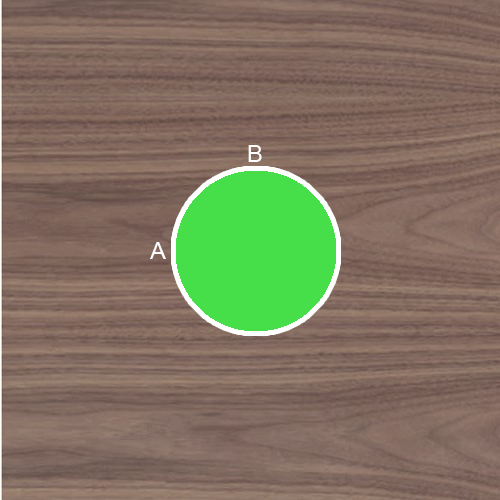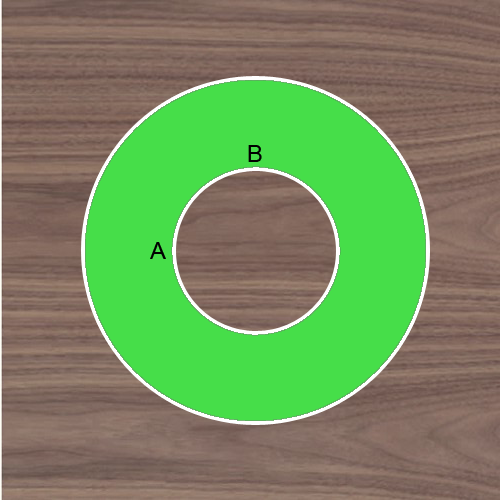Cutting against the grain
Quote from Deleted user on March 30, 2018, 3:30 amOK. Carving newbie here. Still confused about this "against the grain" concept. I have attached two files. In one image, a donut is shown, and according to the Woodcarving Basics handout, the arc from A to B should be cut clockwise. The other image is of the "donut hole." The arc from A to B is the same arc - but now the arc is on the outside of the "donut hole," rather than the inside of the "donut." Based on the handout, it seems to me that this should now be cut from B to A.
But it's the same arc. Exactly the same. So how does it make sense that if we call this arc "outside," we have to cut from B to A to avoid tearing or splitting the wood...but if we call it "inside," we have to cut from A to B to avoid tearing or splitting the wood?
I'm probably just being slow. Thank you for your help and patience.
OK. Carving newbie here. Still confused about this "against the grain" concept. I have attached two files. In one image, a donut is shown, and according to the Woodcarving Basics handout, the arc from A to B should be cut clockwise. The other image is of the "donut hole." The arc from A to B is the same arc - but now the arc is on the outside of the "donut hole," rather than the inside of the "donut." Based on the handout, it seems to me that this should now be cut from B to A.
But it's the same arc. Exactly the same. So how does it make sense that if we call this arc "outside," we have to cut from B to A to avoid tearing or splitting the wood...but if we call it "inside," we have to cut from A to B to avoid tearing or splitting the wood?
I'm probably just being slow. Thank you for your help and patience.
Uploaded files:Quote from SmokyRick Crawford on March 30, 2018, 9:05 amBasically, you just need to try it and you will see some of what is trying to be shown. Take a pad of paper in one hand and think about trying to cut it from the open end toward the bound edge. Look at the side of the pad and you will see the grain, as it is in the wood. Think about it and you will see.
When cutting the wood, you need to keep the ends of the fibers from being pulled out and splintering off.
Basically, you just need to try it and you will see some of what is trying to be shown. Take a pad of paper in one hand and think about trying to cut it from the open end toward the bound edge. Look at the side of the pad and you will see the grain, as it is in the wood. Think about it and you will see.
When cutting the wood, you need to keep the ends of the fibers from being pulled out and splintering off.
Quote from Deleted user on March 30, 2018, 9:36 amThanks Rick! Anyway, let me try to restate my question more clearly, in case anyone else wants to add to the discussion.
In terms of an initial cut, it seems to me that you are always going with the grain on one side of the cut and against the grain on the other side of the cut. That initial cut isn't like stroking a cat's fur. It's like tying two cats side to side, facing in opposite directions, and running your hand between them. At least one of the cats is not going to be happy. If you don't believe me, you just need to try it and you will see.
Anyway, in the carving situation, it makes sense to have the "happy cat" be the side with your design and the "unhappy cat" be the side with the waste wood you are removing. But it doesn't make sense, at least not to me, to say that the direction of that initial cut determines whether your gouge will "catch," or whether it will "tear and split the wood." As I see it, the cut will tear and split the wood in exactly the same amount, regardless of the direction; the only question is which side of the cut suffers more damage.
Thanks Rick! Anyway, let me try to restate my question more clearly, in case anyone else wants to add to the discussion.
In terms of an initial cut, it seems to me that you are always going with the grain on one side of the cut and against the grain on the other side of the cut. That initial cut isn't like stroking a cat's fur. It's like tying two cats side to side, facing in opposite directions, and running your hand between them. At least one of the cats is not going to be happy. If you don't believe me, you just need to try it and you will see.
Anyway, in the carving situation, it makes sense to have the "happy cat" be the side with your design and the "unhappy cat" be the side with the waste wood you are removing. But it doesn't make sense, at least not to me, to say that the direction of that initial cut determines whether your gouge will "catch," or whether it will "tear and split the wood." As I see it, the cut will tear and split the wood in exactly the same amount, regardless of the direction; the only question is which side of the cut suffers more damage.
Quote from MaryMay on April 2, 2018, 10:28 amHi David,
It might make more sense to completely cut the donut out on a scroll saw (drill a hole in the center and insert scroll saw blade), rather than having to deal with lowering the background. The huge difference between the outside of the donut and the inside of the donut is that you are rounding off each surface. But... to keep from snagging the wood and going in the wrong grain direction, you will need to round these edges coming from different directions. The outside, in order to cut with the grain and not snag or catch the outside edge of the donut should be cut from the point B to point A in your illustration. The inside of the donut will round the donut from Point A to Point B. If you try and round the inside of the donut from Point B to Point A it will immediately catch the grain.
Put the tool to the wood, and I think it will begin to make much more sense.
Good luck 🙂
Hi David,
It might make more sense to completely cut the donut out on a scroll saw (drill a hole in the center and insert scroll saw blade), rather than having to deal with lowering the background. The huge difference between the outside of the donut and the inside of the donut is that you are rounding off each surface. But... to keep from snagging the wood and going in the wrong grain direction, you will need to round these edges coming from different directions. The outside, in order to cut with the grain and not snag or catch the outside edge of the donut should be cut from the point B to point A in your illustration. The inside of the donut will round the donut from Point A to Point B. If you try and round the inside of the donut from Point B to Point A it will immediately catch the grain.
Put the tool to the wood, and I think it will begin to make much more sense.
Good luck 🙂
Quote from Dan Krager on May 5, 2018, 10:45 pmThere appears to be some confusion about the ambiguous sketch. What does the green dot mean? Is it a depression in the wood or a dome in the first sketch? Yes, it's meant to show a donut in the second sketch, but a donut is a fully 3D toroid. If the green is intended to show a donut shaped cove (concave) in an otherwise flat panel that's one thing. If it is a donut shaped convex curve on an otherwise flat panel, then that is a whole different beast. Also this description allows for a single pass cut of a gouge traversing the arc making simultaneous "uphill" and "downhill" cuts. There are just too many unknowns without further definition of the actual contour.
Rather than use uphill, downhill, A-B, B-A which, as you can see as sketched is just too ambiguous to be useful, let's think about shorter and longer fibers. As a cutting edge, curved or straight, passes wood fibers in a straight or curved path, the cutting edge will be slicing fibers, (like straws in a bundle) the first of the left behind fibers will become "short" fibers and subsequent fibers underneath the first will be left longer as the cut deepens. So the cut is proceeding from short to the next longest left behind fibers. The first cut fibers are supported by the ones beneath them all the way through the cut and the result is clean and smooth. When the grain changes direction under the cut, the cut may begin to follow between the grain fibers (where the bond is weakest) and follow the grain deeper and deeper into the body forcing the gouge to split the wood instead of slice it. When this happens the fibers being "cut" are no longer supported by the body of the longer fibers underneath. The gouge can lift or split the fibers instead of cutting them because there is no adequate support in the direction of cut. The angle of attack and the orientation of the bevel have a great influence on this behavior. (The role of the bevel is often ignored, but it is as important as the sharpness of the cutting edge.) So does the nature of the wood being cut. A stringy wood with major difference of density between rings will have a pronounced tendency cause the gouge to follow the soft wood between the growth rings. A wood with more uniform density, like basswood, does not have the same tendency.
So, in short (so to speak), you want the cutting edge to move from short fibers to long fibers (underneath the cut)=slicing, not long to short=splitting or "digging in".
Does that help? (I hope)
DanK
There appears to be some confusion about the ambiguous sketch. What does the green dot mean? Is it a depression in the wood or a dome in the first sketch? Yes, it's meant to show a donut in the second sketch, but a donut is a fully 3D toroid. If the green is intended to show a donut shaped cove (concave) in an otherwise flat panel that's one thing. If it is a donut shaped convex curve on an otherwise flat panel, then that is a whole different beast. Also this description allows for a single pass cut of a gouge traversing the arc making simultaneous "uphill" and "downhill" cuts. There are just too many unknowns without further definition of the actual contour.
Rather than use uphill, downhill, A-B, B-A which, as you can see as sketched is just too ambiguous to be useful, let's think about shorter and longer fibers. As a cutting edge, curved or straight, passes wood fibers in a straight or curved path, the cutting edge will be slicing fibers, (like straws in a bundle) the first of the left behind fibers will become "short" fibers and subsequent fibers underneath the first will be left longer as the cut deepens. So the cut is proceeding from short to the next longest left behind fibers. The first cut fibers are supported by the ones beneath them all the way through the cut and the result is clean and smooth. When the grain changes direction under the cut, the cut may begin to follow between the grain fibers (where the bond is weakest) and follow the grain deeper and deeper into the body forcing the gouge to split the wood instead of slice it. When this happens the fibers being "cut" are no longer supported by the body of the longer fibers underneath. The gouge can lift or split the fibers instead of cutting them because there is no adequate support in the direction of cut. The angle of attack and the orientation of the bevel have a great influence on this behavior. (The role of the bevel is often ignored, but it is as important as the sharpness of the cutting edge.) So does the nature of the wood being cut. A stringy wood with major difference of density between rings will have a pronounced tendency cause the gouge to follow the soft wood between the growth rings. A wood with more uniform density, like basswood, does not have the same tendency.
So, in short (so to speak), you want the cutting edge to move from short fibers to long fibers (underneath the cut)=slicing, not long to short=splitting or "digging in".
Does that help? (I hope)
DanK


